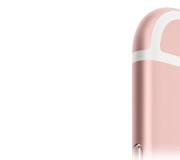The name of the children's game with geometric shapes. Ready-made games with geometric shapes for preschoolers
What shapes to learn at an early age and how to conduct classes so that the names of the shapes are better remembered?
- By the age of three, teach your baby to distinguish and name a circle, a square, and a triangle. Learn the definitions of "round", "square" and "triangular", teach to distinguish the shape of objects in pictures and in life. Play a lotto in which you need to sort the pieces according to their shape, even if they are different color... Match large and small shapes. Form complex tasks that include elements of logic: "Put aside the big yellow circle and the small green triangle." Such tasks, in spite of their apparent simplicity, will require a small child to concentrate all his mental powers - which means that they will be developing for him.
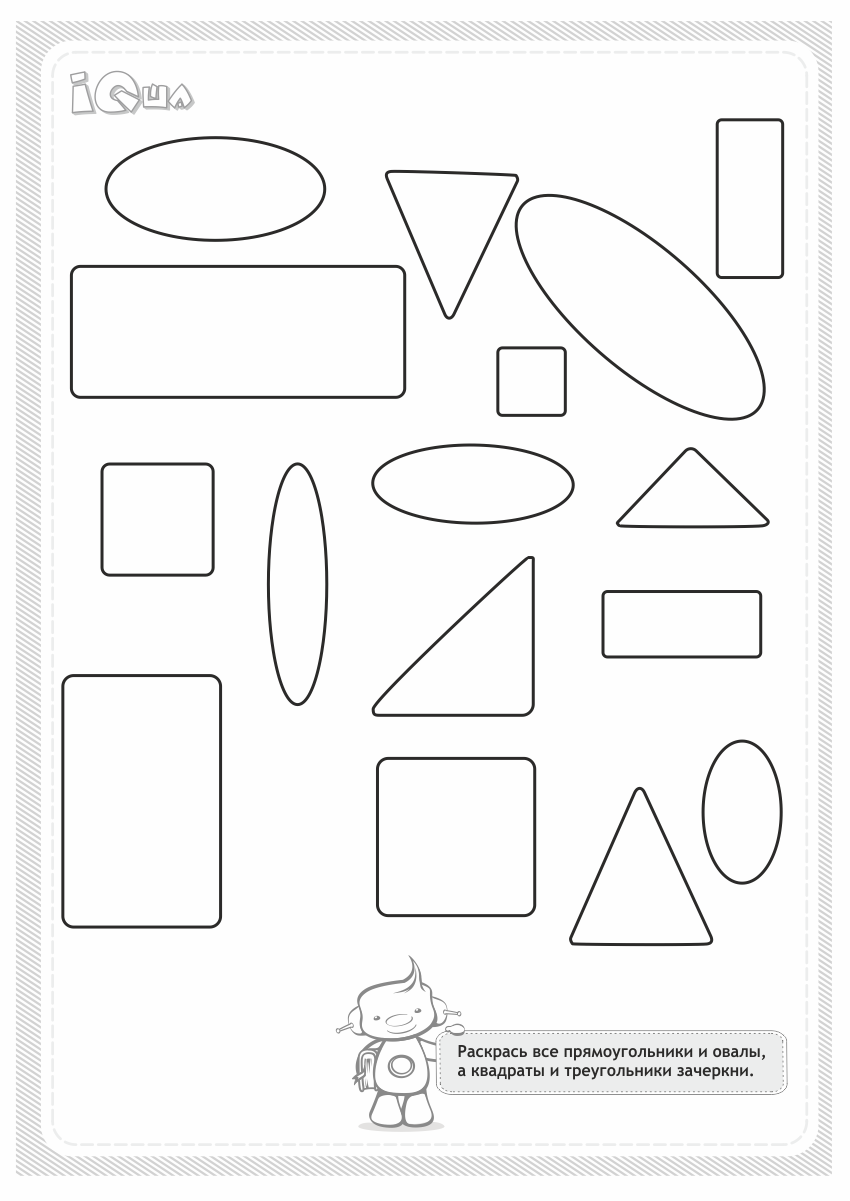
- After making sure that the child has mastered the simplest shapes, include an oval, a rectangle and a trapezoid in the exercises. Accept that the child will confuse names for a long time: he can call a rectangle a square or a triangle, and a triangle - a rectangle, because for a preschooler, the key part of the word "gon" overshadows the rest of the meanings. Begin to pay attention to the fact that the Triangle is so called because it has THREE angles. Keep on formulating logic tasks: "Choose a large yellow trapezoid and a large orange triangle."
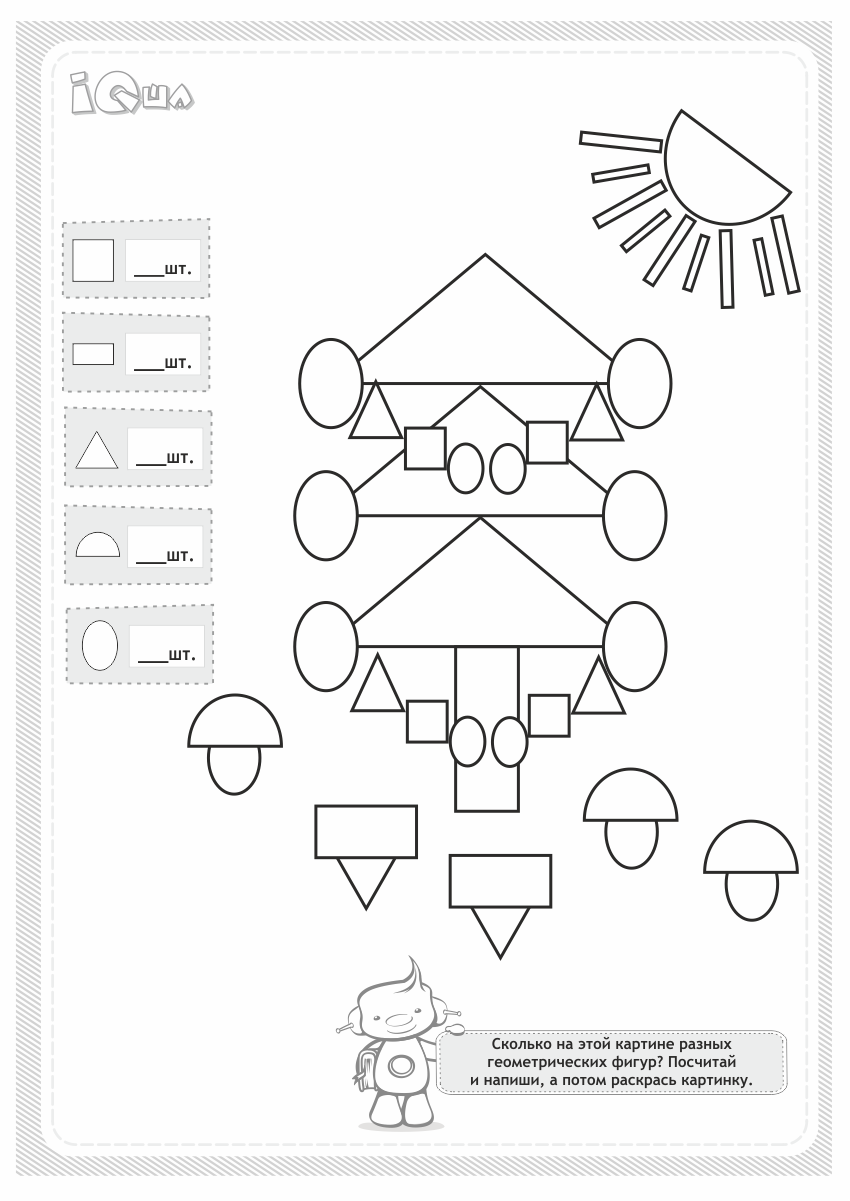
- In order to learn to distinguish between shapes, mix a large number of similar shapes - ovals and circles, squares and rectangles, triangles and trapezoids - lay them out on the table and ask to put only some shapes in one bowl, and leave others on the table. Let, at the very initial stages, all the figures be of different colors, and the figures of the same type - the same size... To complicate the task, mix up the colors of the shapes, then resize them. Also try to give the kid tasks in which you need to sort out shapes of the same color, but different in size and shape.
- Place two sets of large pieces on the floor. Name a figure and jump on it, and have the child do the same. Now ask him to jump on the same figures as you, but out loud you will name another figure.
- What figures do you need to know for school?
- By the age of 7, it is desirable for a preschooler to distinguish three-dimensional figures: a cone, a ball and a cube. It is important not to confuse their names with flat shapes: triangle, circle and square.
- From flat figures, introduce the older preschooler to a semicircle, a star, a polygon and a crescent. These figures can be distinguished very easily, and their use in drawings or mosaics will enrich the plot of the pictures compiled by the child.
- By school, the child should know what a point and a straight line are. To develop his horizons, you also introduce him to the broken line and curve.
The game "Houses" is based on the game with geometric figures "Minks - houses" by Tatiana Barchan
After listening to a webinar with the participation of Tatiana Barchan at the Game Workshop, I fired up the idea of creating math games for my kid. I would like to present to you my version of "Little Houses".
Game 1. Game with geometric figures "Minks - houses": Tatiana Barchan's game
Tatiana Barchan is our regular author of the Internet Workshop of educational games "Through the game - to success!" and sponsor of the "Native Path" contests. She leads the theme of logic and mathematical games with children in the Game Workshop. And also on the Native Path there is an article from Tatyana's speech games - Tatyana Barchan - director of the Rebus Center for Education and Creative Development, teacher of the highest category, laureate of the Professional Vocation competition in the Best Teacher preschool education", Author of dozens of manuals and games for preschool and younger children school age from the series “Rebus's Game Library. Tatiana Barchan's Games ”, Tatiana has been creating exciting educational games for children for over 25 years. Her games have been awarded medals at numerous exhibitions, and also received the Toy of the Year - Recommended by Child Psychologists award.

Mink is a lotto game for the youngest children aged 2 and up. She introduces kids to geometric shapes, color, shape, size, teaches to count to three. You can easily do it yourself.
We will need for the game:
- big cards - slides of different colors, in which minks are carefully carved - holes of different shapes and sizes,
- mink windows(geometric shapes), one side of them is colored and matches the color of the slide, a character is glued to the other side, the window tightly closes the mink and matches it in color, shape and size,
- next to each slide, a hero is glued onto a large card oh to create the plot of the game, because kids need live math.
Characters on the back of the mink windows should be 3-4 types. For example, in Tatiana Barchan's game, these are mice, turtles, butterflies and snails. Each slide can contain from 1 to 3 identical characters. For example, one snail, three mice and one butterfly. Or one snail, two mice, two turtles.
TO How to play the game with geometrical figures "Minks":
- We deal big cards to the players. And we give the small cards to the presenter of the game - an adult.
- An adult shows a window and names it, for example: "Big red circle" (called shape + color + size of a geometric figure)
- If the baby has such a mink, he takes the window for himself and closes the mink with it in his slide. The window must match the mink in color and size.
- When all the windows are closed, the children turn the windows over and see who lives in their slide. And they count them, for example: two snails, one butterfly, two mice live in burrows.
And here is how Olga made this game for her son.
Game with geometric shapes "Houses": a game by Olga Zagorats
Used materials
colored cardboard, animal stickers, scissors, cutter, glue, transparent tape.
How is the game made
For each house, I cut out a body and a roof of a fancy shape, then I cut out windows of different shapes from them. I fixed the houses on a sheet of cardboard. On the cut out windows with back side I glued the animals, then laminated them with tape for strength. That's it, the game is ready!
I made four houses for testing. Since the game is already more than a year remains relevant and one of the favorites, on currently we have already had more than 10 houses. One set is at our house, the other is at my grandmother's.
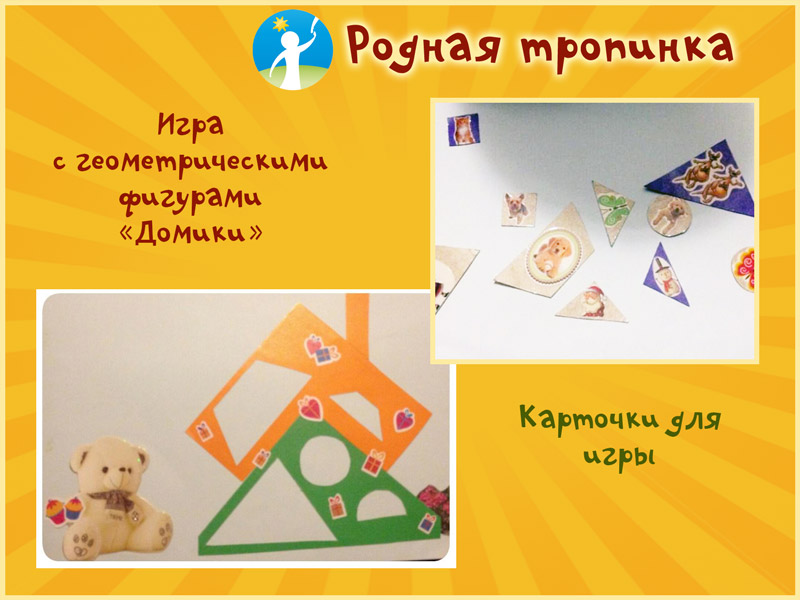
How my son and I play this geometric shape game
Game variant 1. Lotto
Houses (2-3 large cards each) are dealt to the players. The presenter takes turns taking the windows out of the box. When naming the size, color, shape, you need to find a place for the window.
V recent times all the better it turns out to work by ear - even without seeing the window, according to the characteristics (description of the shape, color, size), the child is looking for a place for the window in the house.
When the task is completed, the long-awaited moment comes - we look "who lives in the little house." We turn the windows over and count the tenants!
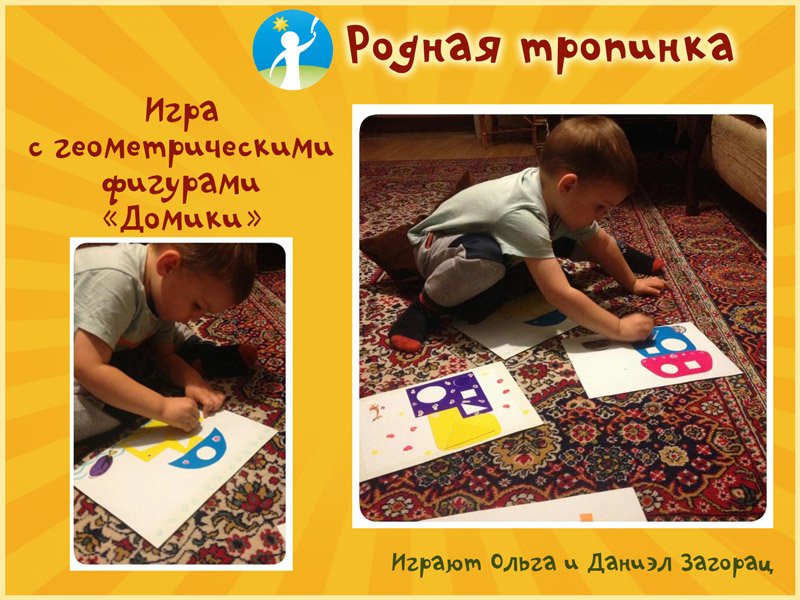
Game variant 2. Classification
Disassemble all windows according to certain criteria (all small, all triangular, etc.). In this version, only cards are used - windows. Boxes with houses are not included.
Game variant 3. Shops
This version of the game is "commercial". The cardboard boxes with houses are shops. Small cards with pasted pictures are money (a window with 2 pictures - dogs is equal to two rubles). Next comes the classic game of the store with the sale and purchase of balls, fruits, sweets for one, two or three rubles.
Thanks to Olga for sharing her game, thanks to little Daniel for the inspiration! I am sure that his example will inspire many mothers of babies to also start making this game with geometric shapes with their own hands.
Ready-made games with geometric shapes for preschoolers
You don't always need to make a game with your own hands. Nowadays, wonderful high-quality, very exciting and beautiful logic-mathematical games for young children are being published. All readers of "Native Path" can get acquainted with complete list games with geometric figures by Tatiana Barchan on her website “Game Library Rebus. Games of Tatiana Barchan " and order them directly from the author's hands without intermediaries' extra charges. To do this, enter the word "Native path" when ordering.
There are a lot of wonderful games with geometric shapes for preschoolers in the Rebus game library. It:
- "Geometry on a String",
- "Where is the mouse?"
- "Other forms"
- "Logical geometric"
- "Third wheel"
- "Chocolate Slices".
In each game, not only the problem of acquaintance with geometric figures is solved, but also the logical thinking of children, attention and perception, there is an acquaintance with the color, size of objects, their parts and location in space.
And we have already organized 5 meetings - a toy library with the author. And we will definitely continue them.
We wish you an interesting journey to the land of geometric shapes! And creative inspiration in playing with children.
> Didactic games and exercises to consolidate the concept of geometric shapes
In the mathematical development of preschoolers, an important teaching tool is widely used - play. However, it becomes effective if it is applied “in the right place, in the right time and in the required doses ”.
Most often, didactic games and exercises are used to consolidate ideas about geometric shapes. Let's consider the most interesting of them.
Games for younger preschoolers.
Game "Geometric Lotto". For the game, you will need cards on which geometric shapes (one-color outlines) are depicted in a row. The cards show a different selection of figures. On one - a circle, a square, a triangle; on the other - a circle, a square, a circle; on the third - a triangle, a triangle, a circle; on the fourth - a square, a triangle, a circle, etc. In addition, each child has a set of geometric shapes of the same size as the outline images on the cards (two shapes of each shape in different colors).
At the beginning of the lesson, the child lays out all the figures in front of him. The card lies on the table in front of him. The teacher shows the figure, invites the children to find the same in themselves and lay out on the cards so that they coincide with the ones drawn.
Depending on the knowledge and skills of children, the game is simplified or complicated (there may be more or less figures).
The game "Put in boxes". In this game, boxes are used, on which contour images of figures are given, and circles, squares, triangles of various colors and sizes.
The task for the children is to put things in order, arrange all the figures in the boxes. Children - first examine the boxes and determine which one to put what to put. Then they arrange the figures into boxes, correlating their shape with the outline image.
In this game, children learn to group geometric shapes, abstracting from color and size.
Game "Find your house". Children are given geometric shapes that differ in color and size. A circle, a square and a triangle lie on the floor in three hoops in different corners of the room.
"In this house all the circles live," says the teacher, "in this one are all the squares, and in this one are all the triangles." When everyone has found their houses, the children are invited to "take a walk": to run around in the group. At the signal of the teacher (hitting the tambourine), everyone finds their house, comparing their geometric figure with the one in the house. The game is repeated several times, with the teacher changing the houses each time.
Game "Find a Pair". On the table are mittens cut out of paper, one of which depicts, for example, a circle and a triangle, on the other - a circle and a square, on the third - two triangles, etc. Each of the children also has one mitten, they must find themselves a pair of mittens, guided by the pattern.
Game "Find your figure". The teacher makes a box out of cardboard, in which holes of a triangular, round, square shape are cut. The purpose of the lesson is to teach children to distinguish and correctly name geometric shapes.
The teacher divides the children into two groups: some have geometric shapes, matched according to the cuts on the box; others - envelopes with the image of a circle, triangle, square. The game consists in the fact that some children put geometric figures into the box (each in the corresponding slot), while others must select them from the box, guided by the images on their envelopes.
In such a game, cognitive communication of children necessarily arises, due to which the speech activity of the players appears. For example, it is always important for a child not only whether he found his figure correctly, but also whether his friend found the figure correctly. At the same time, children very well see each other's mistakes: “What do you take? You have a triangle! " or “This, take this! You see: here is a square and here is a square. "
All such games are valuable because the children are faced with only a game task, and only the educator who organizes the lesson knows that this or that program material is assimilated.
Games for middle-aged children.
The game "Wonderful Sack" is well known to preschoolers. It allows you to examine geometric shape objects, exercise in distinguishing forms. The bag contains models of geometric shapes. The child examines them, feels and names the figure he wants to show.
It is possible to complicate the game if the presenter gives the task to find a specific figure in a wonderful bag. In this case, the child sequentially examines several figures until he finds the one he needs. This version of the job is slower. Therefore, it is advisable that every child has a wonderful bag in the hands.
The game "Wonderful Sack" can also be played with models of geometric bodies, with real objects that have a clearly defined geometric shape.
Game "Who will see more?" Various geometric shapes are placed in random order on the flannelgraph. Preschoolers examine and remember them. The leader counts to three and closes the pieces. Children are asked to name as many different figures as possible that were on the flannelgraph. To prevent children from repeating the answers of their comrades, the presenter can listen to each child separately. The one who remembers and names more figures wins, he becomes the leader. Continuing the game, the host changes the number of pieces.
Find the same game. In front of the children are cards with three or four different geometric shapes. The teacher shows his card (or names, lists the figures on the card). Children must find the same card and pick it up.
The game "Look Around" helps to consolidate the idea of geometric shapes, teaches you to find objects of a certain shape.
The game is held in the form of a competition for individual or team championship. In this case, the group is divided into teams.
The presenter (it can be a teacher or a child) offers to name objects of a round, rectangular, square, quadrangular shape, the shape of objects that do not have corners, etc. For each correct answer, the player or the team receives a chip, a circle. The rules stipulate that you cannot name the same item twice. The game is played at a fast pace. At the end of the game, the results are summed up, the winner is called the largest number points.
The game "Geometric Mosaic" is designed to consolidate the knowledge of children about geometric shapes, forms the ability to transform them, develops imagination and creative thinking, teaches to analyze the way the parts are arranged, make a figure, focus on the sample.
By organizing the game, the teacher takes care of uniting the children into one team in accordance with the level of their skills and abilities. Teams receive tasks of varying difficulty. To compose an image of an object from geometric shapes: work according to a ready-made dismembered sample, work according to an undivided sample, work according to conditions (to assemble a human figure - a girl in a dress), work according to one's own design (just a person). Each team receives the same set of geometric shapes. Children must independently agree on the methods of completing the assignment, on the order of work, and choose the source material.
Each player in the team in turn participates in the transformation of a geometric figure, adding his own element, making individual elements subject from several figures. At the end of the game, children analyze their figures, find similarities and differences in solving a constructive idea.
One of the options for the game can be the fulfillment of tasks of varying complexity at the request of the children individually.
Children's knowledge of geometric shapes is also consolidated in outdoor games. Game "Find your house". Children receive one model of a geometric figure and run around the room. At the signal of the presenter, everyone gathers at their house with a picture of a figure. You can complicate the game by moving the house.
Children are taught to see the geometric shape in the surrounding objects: a ball, a watermelon - a ball; plate, saucer, hoop - circle; table top, wall, floor, ceiling, window - rectangle; shawl - square; kerchief - triangle; glass - cylinder; egg, zucchini - oval.
You can recommend such tasks. Children are given several object pictures. The teacher or child takes one of the geometric shapes at random from a wonderful bag and names it. Anyone in the picture with objects close to this shape (round, oval, square, rectangular, quadrangular), raise the card.
Another task. There is a picture on the board that depicts many different objects (houses, vehicles, toys, sports equipment, fruits, vegetables, furniture, dishes, etc.). Children hold models of geometric shapes. The teacher points to one of the items. The guys determine what shape a given object is, show the corresponding geometric figure and name other objects of the same shape in the picture.
Exercises for recognizing and naming geometric shapes, as well as recognizing shapes in various objects, can also be carried out in drawing, modeling, appliqué classes, during observations and excursions to nature, as well as outside classes, using the board games "Dominoes" loved by children. "Geometric lotto", etc.
Games for recreation of figurative and plot images from geometric figures for older children preschool age.
A special place among mathematical entertainment is occupied by games for drawing up plane images of objects, animals, birds, houses, ships from special kits geometric shapes. In this case, the sets of figures are not selected randomly, but are parts of a figure cut in a certain way: a square, rectangle, circle or oval. They are interesting for children and adults. Children are fascinated by the result - to compose what they saw on the sample or what they planned. They are involved in active practical activity on the selection of the way the figures are arranged in order to create a silhouette.
Game "Tangram"
"Tangram" is one of the simple games. It is also called "Cardboard Puzzle", "Geometric Constructor", etc. The game is easy to manufacture. A 8X8 cm square made of cardboard, plastic, equally colored on both sides, cut into 7 parts. The result is 2 large, 1 medium and 2 small triangles, a square and a parallelogram. Using all 7 parts, tightly attaching them to one another, you can make a lot different images according to samples and according to their own design (Fig. 1).
The success of mastering the game at preschool age depends on the level sensory development children. Children should know not only the names of geometric figures, but also their properties, distinctive features, master the methods of examining forms by visual and tactile-motor paths, freely move them in order to obtain a new figure. They must have developed the ability to analyze simple images, to highlight geometric shapes in them and in the surrounding objects, practically modify the figures by cutting and compose them from parts.
Consecutive stages of mastering the game "Tangram" in a group of older preschool children.
The first stage is familiarization with the set of figures for the game, transforming them in order to compose a new one from 2-3 existing ones.
Target. Exercise children in comparing triangles in size, composing new geometric shapes from them: squares, quadrangles, triangles.
Material: children have sets of figures for the game "Tangram", the teacher has a flannelegraph and a set of figures for it.
Progress. The teacher invites the children to consider a set of figures, name them, count and determine the total number. Gives tasks:
Analysis questions: "How many large, equal-sized triangles? How many small? Compare this (medium-sized) triangle with the large and small. (It is larger than the smallest and smaller than the largest one.) How many triangles are there and what size are they?" (Two large, 2 small and 1 medium sized.)
2. Take 2 large triangles and make them sequentially: square, triangle, quadrangle. One of the children composes figures on the flannelgraph. The teacher asks to name the newly obtained figure and say which figures it is composed of.
3. Make up the same figures from 2 small triangles, placing them differently in space.
4. Make a quadrangle from the large and medium-sized triangles.
Questions for analysis: "What shape will we make? How? (Attach the middle one to the large triangle or vice versa.) Show the sides and corners of the quadrilateral, each individual shape."
As a result, the teacher generalizes: "Triangles can be used to form new different shapes - squares, quadrangles, triangles. The shapes are attached to one another along the sides." (Points to the flannelgraph.)
Target. Exercise children in the ability to compose new geometric shapes from the existing ones according to the model and design.
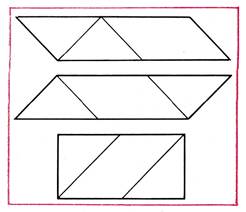
Material: for children - sets of figures for the game "Tangram". The teacher has a flannelegraph and tables with geometric figures depicted on them.
Progress. Children, having examined the figures, divide them according to the instructions of the teacher into 2 groups: triangles and quadrangles.
The teacher explains that this is a set of figures for the game, it is called a puzzle or tangram; so she was named after the scientist; who invented the game. Many interesting images can be compiled.
Make a quadrilateral from the large and medium triangles.
Make a new shape from a square and 2 small triangles. (First a square, then a quadrilateral.).
Create a new shape from 2 large and medium triangles. (Pentagon and quadrangle.)
The teacher shows the tables and asks the children to draw up the same figures (Fig. 2). Children sequentially make up figures, tell how they did, name them. The teacher composes them on a flannelgraph.
The task is given to compose several figures according to the children’s own design.
So, at the first stage of mastering the game "Tangram", a number of exercises are carried out aimed at developing spatial representations in children, elements of geometric imagination, at developing practical skills in composing new figures by attaching one of them to another, the aspect ratio of figures in size. Tasks are modified. Children compose new figures according to the model, oral assignment, and design. They are asked to complete the task in terms of representation, and then - practically: "What shape can be made from 2 triangles and 1 square? First say, and then make up." These exercises are preparatory to the second stage of mastering the game - drawing up silhouette figures according to dismembered samples (A silhouette figure is called a subject flat image made up of parts of the game). The second stage of working with children is the most important for them to learn more difficult ways drawing up figures.
To successfully recreate silhouette figures, it is necessary to be able to visually analyze the shape of a plane figure and its parts. In addition, when recreating a figure on a plane, it is very important to be able to mentally imagine the changes in the arrangement of figures that occur as a result of their transfiguration. Most simple form analysis of the sample is visual, but it is impossible without a developed ability to see the proportional relationship of parts of the figure. Compilation method (location component parts), the player is forced to search for silhouette figures from geometric figures, relying on the data of the analysis, in the process of testing various intended compilation options.
Games for drawing up silhouette figures based on dismembered samples (the second stage of work) should be effectively used by the teacher not only for the purpose of exercising in the arrangement of the parts of the composed figure, but also in introducing children to the visual and mental analysis of the sample.
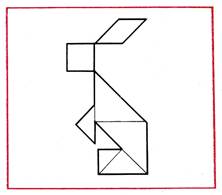
Children are shown a dismembered specimen (hare) (Fig. 3) and the goal is explained: to make the same: Despite the seeming ease of "copying" the method of spatial arrangement of parts, children make mistakes in joining figures on the sides, in proportion. Errors are explained by the fact that children of this age do not have access to an independent analysis of the location of parts. They find it difficult to define and name relative magnitude components, dimensional ratios.
So, children can place a medium-sized triangle instead of a large triangle and notice the error only after the adult's instructions. Thus, based on the characteristics of the analysis and practical action children, it is possible to determine the content of the work at the second stage of the deployment of games: this is the assimilation of the plan of analysis of the presented sample by children, starting with the main parts, and the expression of speech of the method of connection and the spatial arrangement of the parts.
The analysis is followed by drawing exercises focusing on the image. The sample is not removed, children can refer to it again in case of difficulty. It should be made in the form of a table on a sheet of paper and is equal in size to the silhouette figure obtained as a result of compiling a set of figures for the game from the children's set of figures. This makes it easier in the first lessons to analyze and compare (check) the reconstructed image with the sample. In the next lessons, as you gain experience in drawing figures, there is no need to adhere to this rule.
A more difficult and interesting activity for children is the reconstruction of figures according to contour patterns (undivided) - the third stage of mastering the game, which is accessible to children of 6-7 years old, provided they are taught (Fig. 4).

Reconstruction of figures from contour samples requires visual division of the form of a particular figure into its component parts, that is, into those geometric figures from which it is composed. It is possible subject to the correct location of some of the components relative to others, compliance with the proportional ratio of their size. Reconstruction is carried out in the course of the choice (search) of the method of drawing up on the basis of preliminary analysis and subsequent practical actions aimed at checking different ways the relative position of the parts. At this stage of learning, one of the main tasks is to develop in children the ability to analyze the shape of a plane figure from its contour image, combinatorial abilities.
When moving from drawing up silhouette figures from dismembered samples to drawing up from samples without specifying the component parts, it is important to show the children that it is difficult to draw up a figure on a plane without first carefully examining the sample. Children are offered to compose 1-2 figures of silhouettes according to samples of a contour nature from among those that they had previously compiled according to dismembered samples. In this case, the process of drawing up a figure takes place on the basis of the formed representation and the visual analysis of the sample carried out at the beginning of the lesson. Such exercises provide a transition to recreating figures from more complex patterns.
Taking into account the fact that it is difficult for children to accurately indicate the location of the constituent parts in the analyzed undivided sample, it is necessary to invite them to conduct a presumptive analysis of the sample. In this case, everyone analyzes the sample independently, after which several options for the location of the parts are listened to, the correctness or erroneousness of which the teacher does not confirm. This prompts a practical check of the results of a preliminary analysis of the arrangement of parts in the composing figure, the search for new ways of the spatial arrangement of the constituent elements.
Games for drawing up silhouette figures from samples are followed by exercises in drawing up images according to their own design. In the lesson, children are asked to remember which flat figures they learned to compose, and compose them. Each of the children makes up 3-4 figures in turn. These activities also include an element of creativity. When conveying the shape of some silhouette figures, children reproduce the general outlines of the form, and the constituent elements of individual parts are positioned somewhat differently than they did previously according to the model.
In games for independently inventing and composing silhouette figures, children, having conceived to compose any image, mentally, in terms of representation, divide it into component parts, correlating them with the form of tangrams., Then compose. Children come up with and make up interesting silhouette figures that can be used to supplement the stock of samples for the game "Tangram".
Puzzle game "Pythagoras"
(Puzzle "Pythagoras" is produced by the industry with a set of samples attached to it)
In working with children 6-7 years old, play is used to develop mental activity, spatial representation, imagination, ingenuity and ingenuity.
Description of the game. A 7X7 cm square is cut so that 7 geometric shapes are obtained: 2 squares of different sizes, 2 small triangles, 2 large (compared to small ones) and 1 quadrangle (parallelogram). Children call this shape-quadrangle (Fig. 5).
The goal of the game is to make up 7 geometric shapes - parts of the game, flat images: silhouettes of buildings, objects, animals.
The set for the game is represented by figures. Therefore, the game can be used by the educator in teaching children in the classroom in order to consolidate the ideas about geometric shapes, ways to modify them by drawing up new geometric shapes from 2-3 existing ones.
The introduction of children to the game "Pythagoras" begins with an acquaintance with the set of figures that will be required for the game. It is necessary to consider all geometric shapes, count, name them, compare by size, group, selecting all triangles, quadrangles. After that, invite the children to make new ones from the set of figures. From 2 large, and then small triangles, make a square, triangle, quadrangle. In this case, the newly obtained figures are equal in size to those in the set. So, from 2 large triangles, a quadrilateral of the same size is obtained, a square equal in size to a large square. It is necessary to help children notice this similarity of figures, compare them in size not only by eye, but also by superimposing one figure on another. After that, you can compose more complex geometric shapes - from 3, 4 parts. For example, make a rectangle from 2 small triangles and a small square; from a parallelogram, 2 large triangles and a large square - a rectangle.
Taking into account the experience accumulated by children in the process of mastering the game "Tangram", the teacher in the course of teaching a new game uses a number of methodological techniques that contribute to the manifestation of children's interest in it, helping children to quickly master new game while showing creativity and initiative. In the lesson, the teacher offers the children samples to choose from - dismembered and contoured. Each of the children can choose a pattern at will and compose a figure. The teacher points out that it is more difficult and more interesting to compose a silhouette figure according to a model without specifying its component parts. In this case, it is necessary to independently find a way to arrange the parts (Fig. 6).
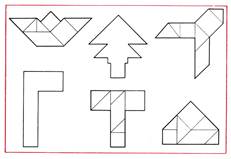
In the process of guiding the activities of children in drawing up silhouette figures, the teacher uses a variety of methods to help keep the children interested, stimulate active mental activity.
1. In case of difficulty in drawing up a silhouette figure according to an undivided sample, offer the child a sample indicating the location of the 1st and 2nd parts of the game from the given 7 parts. The rest of the child disposes on his own. So, in the silhouette of the fungus, the location of one of the large triangles is indicated. In the house there is a large square and a triangle (Fig. 7). V this case the solution of the problem of drawing up a figure is partially prompted by an adult child. This affects the effectiveness of drawing figures, the process of finding a way to arrange them becomes shorter and more successful. Children can superimpose parts of the game directly onto the sample.
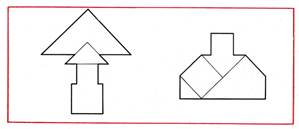
geometric figure thinking preschooler
2. An adult, observing the process of drawing up a figure by a child, confirms correct location separate parts of the game.
For example, in the course of drawing up a silhouette-figure of a triangle, depending on the search for the spatial arrangement of parts, the teacher points to correct definition space for triangles or squares (fig. 8). In this case, the child operates with a smaller number of figures, independently placing them. It also affects the success of the assignment.
3. Analyzing the sample, the teacher invites the child to consider it, think about how the parts of the game are located in it. Allow him to draw on paper a way to arrange the parts or make markings directly on the sample, on a blackboard with chalk. Using techniques graphic image, the practical ways of finding ways to arrange the figures makes the analysis more accurate. Children quickly guess about the method of location, give their options for drawing up a silhouette figure.
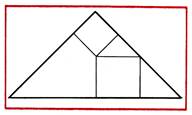
4. After examining the sample, i. E. visual-mental analysis of it, the teacher asks the child to tell about the way the figures are located. At the same time, he emphasizes that he checks his guess practically, every time discarding the wrong solutions. Such an analysis is possible under the condition of developed analyzing perception, flexibility and mobility of thought, constant orientation towards the image of the silhouette figure being composed. The persistent search for new ways to combine figures leads the child to a positive result.
5. A positive assessment of the activity of searching for a way to arrange figures, carried out by children practically, mentally or in a combination of mental and practical actions, is important: encourage, approve of the manifestation of quick wits, perseverance, initiative, the desire to invent and compose a completely new figure or partially modify the sample.
6. As children master the methods of drawing up silhouette figures, it is appropriate to offer them tasks of a creative nature, to stimulate the manifestations of ingenuity and resourcefulness. The silhouette figures, newly invented and compiled by children, are sketched in an individual album.
In the course of learning in the classroom, children of senior preschool age (5-7 years old) quickly master games for recreating figurative, plot images from special sets of figures, which become for them one of the means of filling their leisure time.
1. Game "Call in one word"
Purpose: Development of the ability to name geometric shapes of the same type with a general word.
Material: Geometric figures of the same type (large and small squares; multi-colored triangles, etc.).
2. Game "Pick by size"
Purpose: Development of the ability to classify geometric shapes according to one attribute (size).
Material: Geometric shapes (squares, rectangles, circles, etc.) in two sizes - large and small.
3. The game "Wonderful Sack" is well known to preschoolers. It allows you to examine the geometric shape of objects, to exercise in distinguishing between shapes. The bag contains objects of different geometric shapes. The child examines them, feels and names the figure he wants to show. You can complicate the task if the presenter gives the task to find a specific figure in the bag. In this case, the child sequentially examines several figures until he finds the one he needs. This version of the job is slower. Therefore, it is advisable that every child has a wonderful bag.
4. Game "Find the same" in front of the children are cards, which depict three to four different geometric shapes. The teacher shows his card (or names, lists the Figures on the card). Children must find the same card and pick it up.
5. Game “Who will see more? »Various geometric shapes are arranged in random order on the board. Preschoolers examine and remember them. The leader counts to three and closes the pieces. Children are asked to name as many figures placed on the flannelgraph as possible. So that the children do not repeat the answers of their comrades, the presenter can listen to each child separately. The one who remembers and names more figures wins, he becomes the leader. Continuing the game, the host changes the number of pieces.
7. The game "Look around" helps to consolidate the idea of geometric shapes, teaches to find objects of a certain shape. The game is held in the form of a competition for individual or team championship. In this case, the group is divided into teams. The presenter (it can be a teacher or a child) offers to name objects of a round, rectangular, square, quadrangular shape, the shape of objects that do not have corners, etc. etc. For each correct answer, the player or the team receives a chip, a circle. The rules stipulate that you cannot name the same object twice. The game is played at a fast pace. At the end of the game, the results are summed up, the winner is named with the highest number of points.
8. The game "Geometric Mosaic" is designed to consolidate the knowledge of geometric shapes in children, forms the ability to transform them, develops imagination and creative thinking, teaches to analyze the way parts are arranged, make a figure, focus on a sample. By organizing the game, the teacher takes care of uniting the children into one team in accordance with the level of their skills and abilities. Teams receive tasks of varying difficulty. To compose an image of an object from geometric figures: work according to a ready-made dismembered sample, work according to an undivided sample, work according to conditions (to assemble a human figure - a girl in a dress), work according to one's own design (just a person). Each team receives the same set of geometric shapes. Children must independently agree on the methods of completing the assignment, on the order of work, and choose the source material. Each player in the team takes turns participating in the transformation of a geometric figure, adding his own element, making up individual elements of an object from several figures. At the end of the game, children analyze their figures, find similarities and differences in solving a constructive idea.
9. Game "Find your house". Children receive one model of a geometric figure and run around the room. At the signal of the presenter, everyone gathers at their house with a picture of a figure. You can complicate the game by moving the house. Children are taught to see the geometric shape in the surrounding objects: a ball, a watermelon ball, a plate, a hoop saucer, a circle, a table top, a wall, a floor, a ceiling, a rectangular window, a square shawl; kerchief-triangle; glass cylinder; egg, zucchini - oval.
10. Game "Name a geometric figure"
Target. Teach to visually inspect, recognize and correctly name planar geometric shapes (circle, square, triangle, rectangle, oval)
Material. Tables with geometric shapes. On each table there are contour images of two or three figures in different positions and combinations.
The course of the game.
11. The game is played with one table. The rest can be closed clean slate paper. The adult offers to carefully consider the geometric shapes, draw the contours of the figures with a movement of the hand, and name them. In one lesson, you can show the child 2-3 tables.
12. Game "Find an object of the same shape"
An adult has geometric shapes drawn on paper: a circle, a square, a triangle, an oval, a rectangle, etc.
He shows the child one of the figures, for example, a circle. The child must name an object of the same shape.
13. Game "What's right?"
Purpose: Development of the ability to compare geometric shapes with each other, classify according to shape, attach new shapes to existing groups, designate the base of the group with a word.
Material: Four quadrangles, three triangles, numbers "3", "4".
Game content: Children are given two quadrangles and two triangles, they divide the figures based on the shape. Then the teacher shows the children one triangle and two quadrangles and asks to join them to the already existing groups. Question: to which group does the number "3" fit, and to which number "4"? (Three triangles, each with three corners; four quadrangles, each with four corners).
14. Game "Guess what they hid"
On the table in front of the child are cards with the image of geometric shapes. The child examines them carefully. Then the child is asked to close his eyes, the adult hides one card. After the conventional sign, the child opens his eyes and says what is hidden.
Podolina Galina Petrovna
Silhouette Games with Geometric Material for Older Preschool Children
Ryabichenko Nadezhda Vladimirovna, teacher primary grades MKOU "Mikhailovskaya OSH" of the Kikvidzensky district of the Volgograd regionShort description:
This game can be used with children 5-7 years old. To play, you need to take a square, made of cardboard, plastic or other materials, and cut it along the lines into different shapes. There are 11 shapes in total: two squares, four triangles, one large quadrangle, and four small quadrangles. When composing silhouette figures, all parts are used that are attached to one another, but do not overlap. It is possible to use this game with children 3-4 years old, using samples of already drawn silhouette figures.
Target: the formation of skills to create silhouette figures from polygons
Tasks:
- to consolidate the knowledge of children about geometric shapes;
- to develop cognitive interest, independence, ingenuity, observation, logical thinking, the ability to creative search, the ability to find new ways to solve the problem.
I offer a square template that you can enlarge or shrink as you wish. It doesn't have to be the same size as mine (that's why I don't indicate the size of the square itself).
Previously, with the children, you can look at the square, find out what figures the in consists of by making riddles:
Look at this figure:
She has only three corners.
You are probably ready to name her
By the number of corners. (triangle)
I have three sides
I have three corners.
You will quickly call me
I know about it.
After all, every student knows
Me - I ... (triangle)
I am a figure - anywhere,
I am always very even,
All angles in me are equal
And four sides.
The cube is my beloved brother
Because I ... (square)
Not a triangle or a circle
And I'm not a friend to the oval.
I am a brother to the rectangle
After all, my name is ... (square)
Four corners like a square I have,
But I dare not call myself a square,
And yet, it looks like a square, by the way,
Two long sides, two shorter. (quadrilateral)
We stretched a square
And presented at a glance
Who did he look like
Or something very similar?
Not a brick, not a triangle -
Became a square ... (quadrilateral)
Examples of drawing shapes:
Cow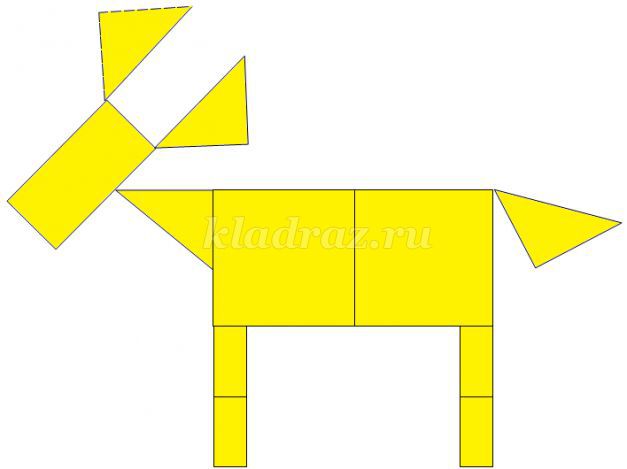
Giraffe
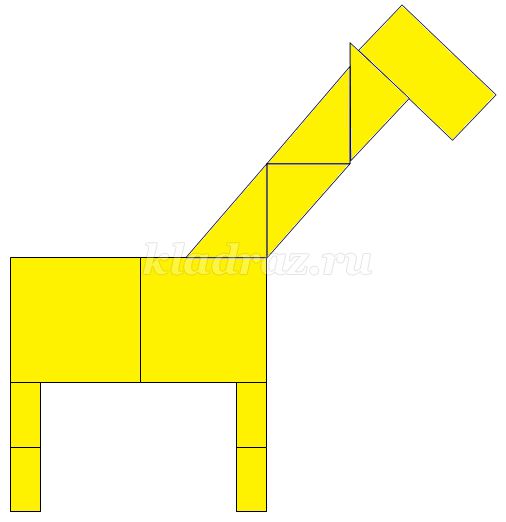
Envelope
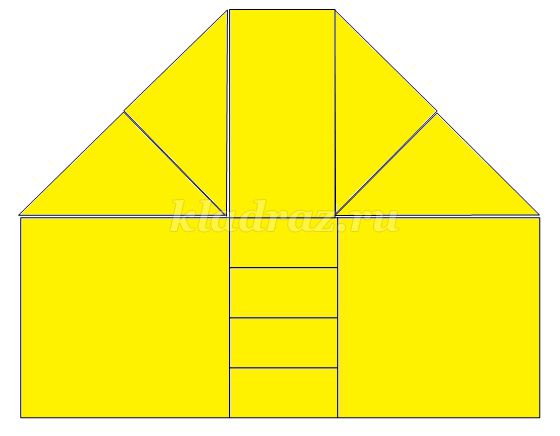
Dog

Tower

I made the game using the DragAndDrop template. This macro was created by programmer Hans Hofmann (Germany).
Working with the DragAndDrop template.
1. Open the program.
2. Click Slide Show, select At first or From the current slide.
3. In the window that appears Security alert choose Include this content then press OK.
4. Performing the work on creating silhouette figures on the slide, you need to click on any figure with the left mouse button one times, move it to Right place, and left-click again. Move all the shapes in the same way.
If the child finds it difficult to complete the task on his own, then he can use the hint. When you click on a word prompt a picture with an image appears in the upper left corner of the slide. When you click on any shape, the hint picture closes.
The hint can be used an unlimited number of times.
To create the next silhouette, you need to go to the next slide.
After completing the task, you can save the work, but it is better to click "do not save".
Games can be used by teachers primary school on extracurricular activities in mathematics with students of grades 1 and 2, as well as kindergarten teachers during classes with preschoolers. This development can be used by parents to organize the leisure of their children.
Presentation on the topic: Math Games with Geometric Shapes



